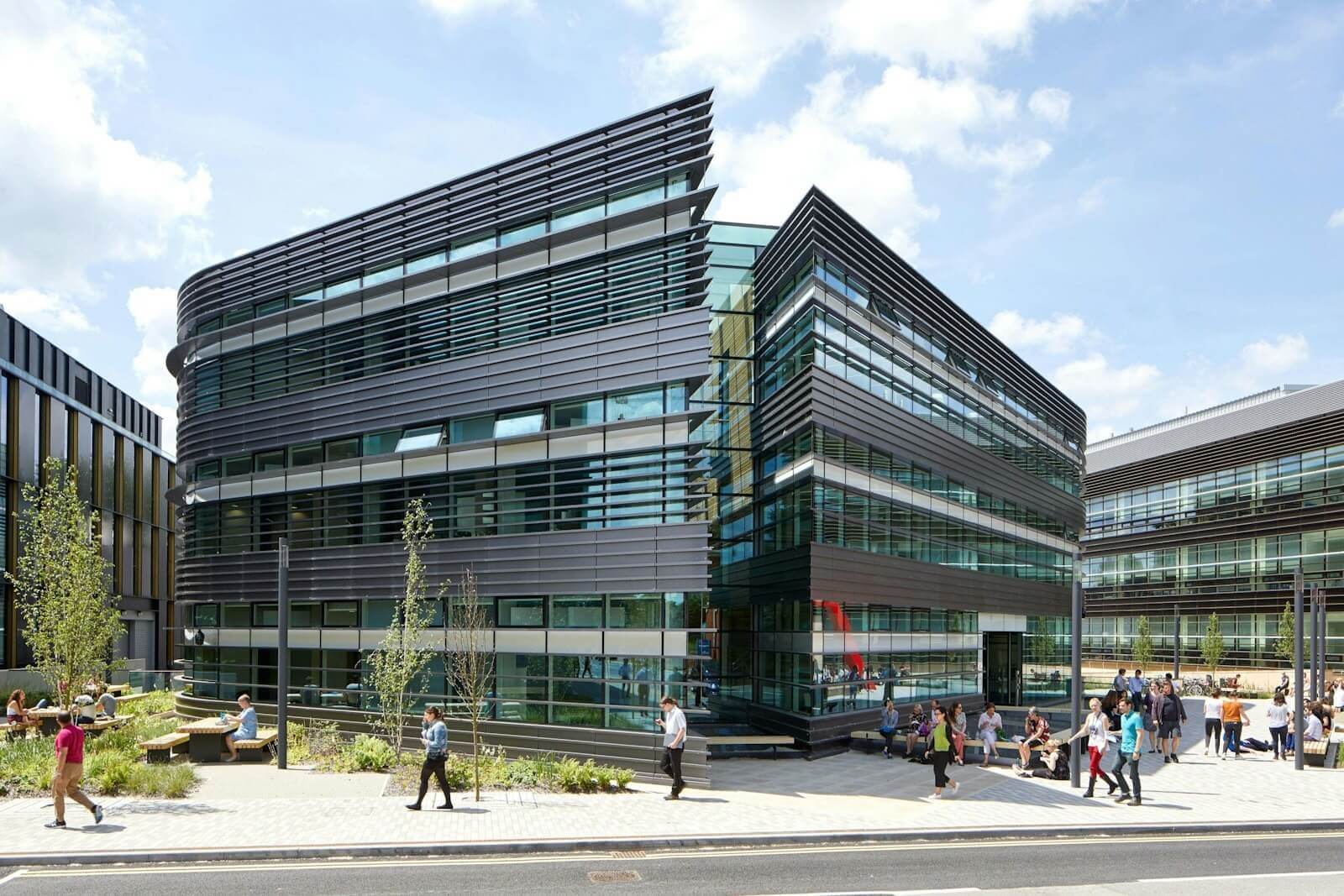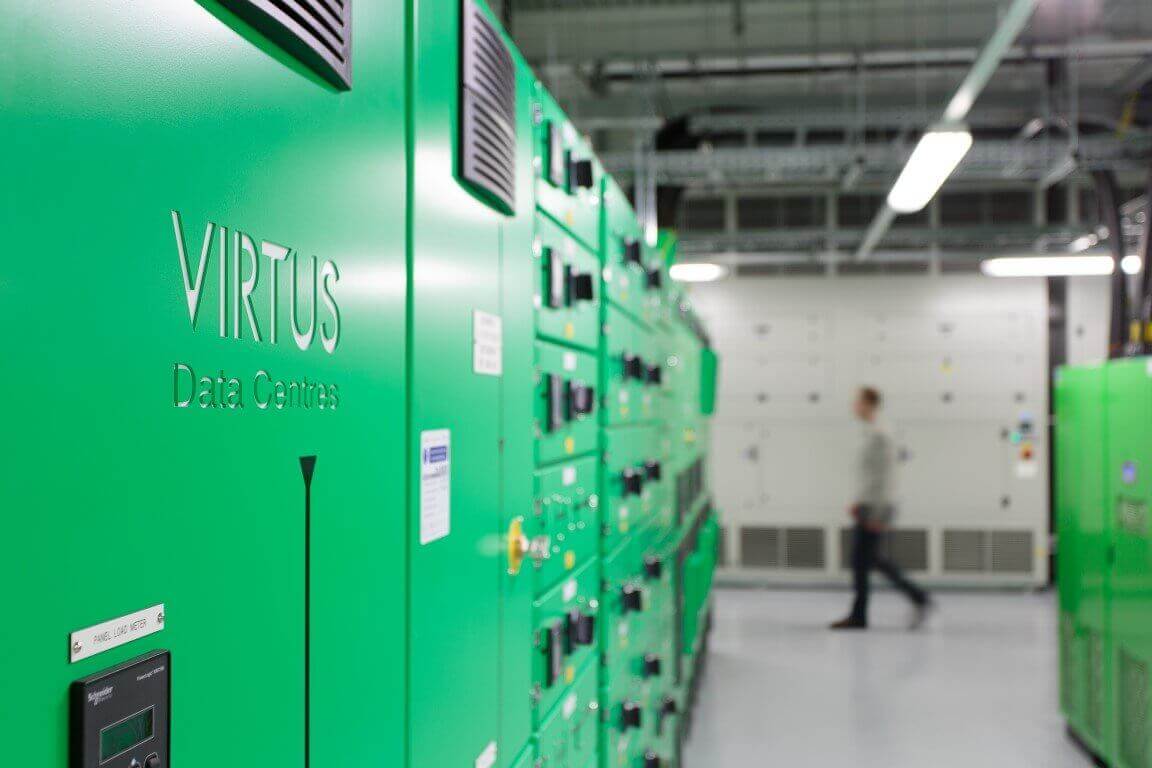Data Centres
Microsoft, Virtus, The Big Data Institute have all implemented fire curtains into the Design of their Data Centres. Find out how and why architects are implementing fire curtains to compartmentalise areas in the event of fire.

The Big Data Institute (part of the University of Oxford)
As architects, designing a data centre involves far more than just the aesthetic or structural aspects; it requires a deep understanding of safety, particularly fire safety. One essential component in protecting data centres from fire hazards is compartmentation — strategically dividing the space into fire-resistant zones to prevent the spread of flames and smoke. Traditionally, this has been achieved using fire-resistant walls, doors, and barriers, but increasingly, architects are turning to an innovative solution: fire curtains.
What Are Fire Curtains?
Fire curtains are flexible, fire-resistant barriers that deploy automatically in the event of a fire. They are typically made from materials such as fibreglass or other fire-resistant fabrics, coated with fire-retardant substances, and stored discreetly in the ceiling or walls. When triggered by a fire alarm or smoke detector, they descend or extend to form a temporary barrier, effectively containing fire and smoke within designated compartments.
Why Fire Curtains Are Ideal for Data Centres
Data centres are unique environments that require a blend of robust fire protection measures and a flexible layout to accommodate evolving technological needs. Fire curtains offer several advantages over traditional compartmentation methods in these settings:
- Flexible Space Planning: Unlike rigid fire-resistant walls, fire curtains can be installed in areas where a more open and adaptable layout is required. They can create fire compartments without permanently obstructing pathways or restricting airflow, which is critical for the cooling needs of a data centre.
- Minimal Aesthetic and Functional Impact: Fire curtains remain concealed within ceilings or walls until needed, preserving the open feel and aesthetic appeal of a space. This makes them particularly useful in areas that require clear sightlines or easy movement for both personnel and equipment.
- Enhanced Protection for High-Risk Areas: Fire curtains can be strategically placed around high-risk areas, such as server racks, cable trays, and power distribution units, to offer targeted protection. This enables a more tailored approach to fire safety, concentrating resources where the risk of fire ignition and spread is highest.
- Effective Smoke Containment: In addition to blocking flames, fire curtains are also designed to control smoke movement, which is a critical factor in data centres. Smoke is often more damaging to sensitive electronic equipment than the fire itself. By preventing the spread of smoke, fire curtains help to protect critical infrastructure and maintain air quality, buying valuable time for evacuation and fire suppression efforts.
Fire Curtains in Data Centres – Case Studies
Coopers Fire have been working with leading architects implementing fire curtains into data centres for over 10 years, working with companies like Virtus Data Centres, Microsoft,The Big Data Institute (part of the University of Oxford) supporting Make architects. If you are looking for advice on the implementation of fire curtains you can contact our technical team who can work with you on fire compartmentation using fire curtains.
Incorporating Fire Curtains into Data Centre Design
When incorporating fire curtains into the design of a data centre, architects should consider several key factors to maximise their effectiveness:
- Integration with Existing Compartmentation Strategies: Fire curtains should be part of a holistic fire safety plan that includes other passive and active measures, such as fire-resistant walls, smoke control systems, and fire suppression equipment. This multi-layered approach enhances overall safety and resilience.
- Optimising Curtain Placement: Strategic placement of fire curtains is crucial. They should be installed to protect critical pathways, isolate high-risk zones, and compartmentalise large open areas without compromising the operational layout of the centre. Consider the positioning of server racks, access points, and airflow systems to determine where curtains will provide the most benefit.
- Coordinating with HVAC and Ventilation Systems: Fire curtains must be compatible with the data centre’s HVAC systems. Proper coordination ensures that the deployment of fire curtains does not interfere with airflows critical for cooling and smoke management. Architects should work closely with HVAC engineers to integrate these systems seamlessly.
- Ensuring Compliance with Local Building Codes and Standards: Different jurisdictions have varying requirements for fire safety in data centres. Architects must ensure that the fire curtains chosen meet or exceed all relevant standards, such as British Standards (BS), European Norms (EN), or other local regulations.
- Regular Testing and Maintenance: To ensure reliability, fire curtains require regular testing and maintenance. Incorporate features that facilitate easy inspection, such as access panels or automated testing systems. This should be part of the building’s overall fire safety management plan.
Best Practices for Using Fire Curtains in Data Centres
- Select High-Quality, Certified Products: Not all fire curtains are created equal. Choose products that are tested and certified for their fire resistance, smoke containment capabilities, and reliability. Look for certifications such as BS 8524, which governs active fire curtain barriers.
- Involve Fire Safety Experts Early in the Design Process: Engage fire safety engineers and experts early to develop a comprehensive fire strategy that integrates fire curtains. Their expertise will help identify potential fire hazards, optimise curtain placement, and ensure compliance with all safety regulations.
- Plan for Future Scalability: Data centres often evolve and expand over time, with new equipment and layouts. Design the fire curtain system to be flexible and scalable, allowing for future adjustments without significant disruptions or costly modifications.
- Educate and Train Personnel: Ensure that all personnel are familiar with the function and operation of fire curtains. Regular fire drills should include scenarios involving fire curtain deployment to ensure everyone understands their role in an emergency.
- Consider Aesthetic and Functional Integration: While safety is paramount, the design of fire curtains should also consider their visual and functional impact on the space. Choose curtain systems that integrate seamlessly with the architectural design, preserving both the functionality and aesthetic appeal of the data centre.
Can fire curtains be used in data centres for fire compartmentation?
Fire curtains represent a significant advancement in fire safety for data centres, offering flexibility, minimal aesthetic impact, and enhanced protection against fire and smoke spread. For architects, they provide a versatile tool to meet the unique fire safety challenges of data centres while allowing for innovative and adaptable design. By integrating fire curtains into a comprehensive fire safety strategy, architects can help safeguard these critical facilities, ensuring the continuous operation of vital services in our increasingly digital world.


